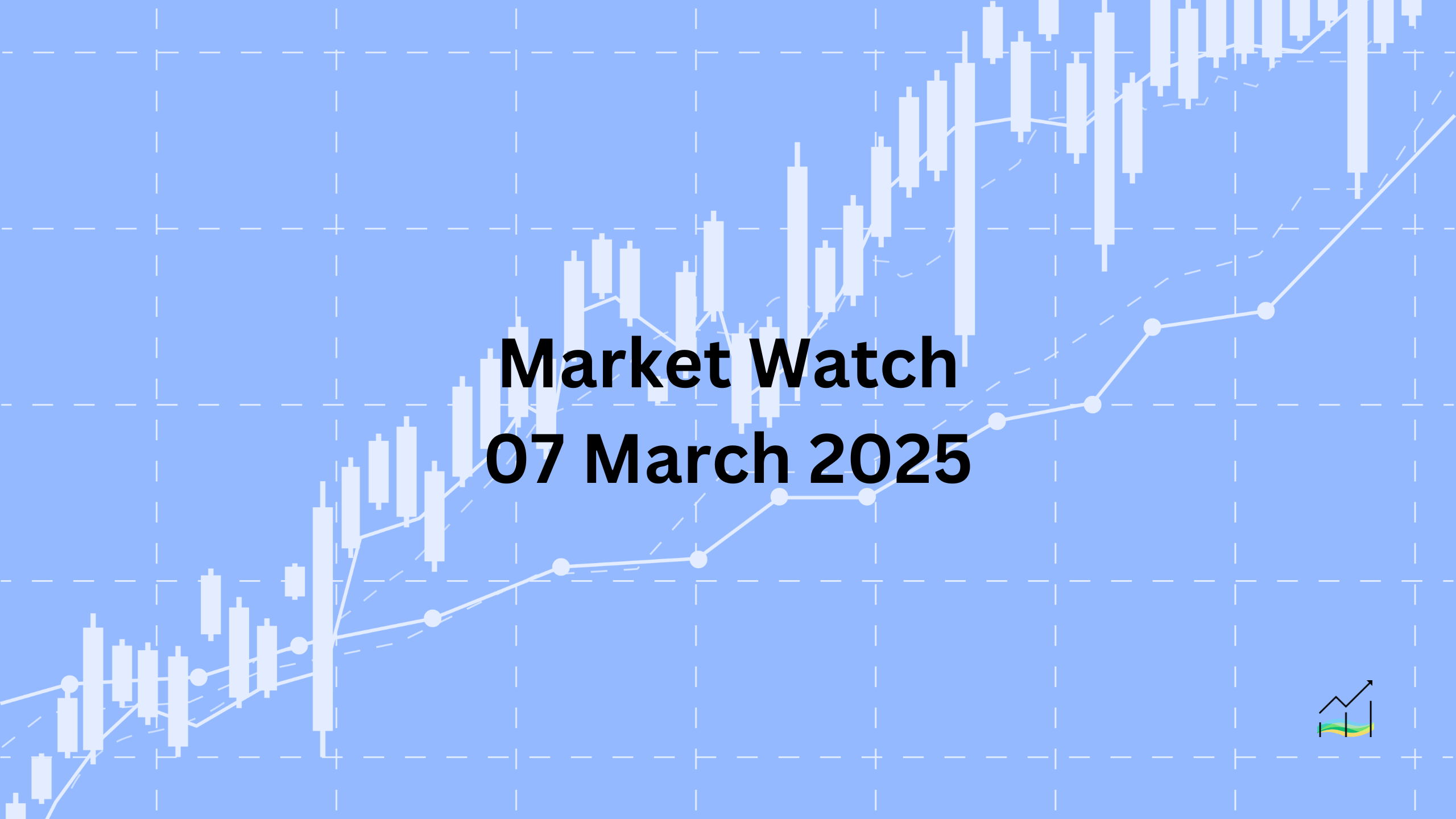07/03/2025 Market Watch

Greenback Retreats Ahead of Key US Data; Euro Hits Multi-Year High
This week saw significant currency movements as the US dollar extended its decline against most major currencies, except for the commodity-linked dollar bloc, which lagged slightly behind. Despite today's cautious mood ahead of crucial US employment figures and Federal Reserve Chair Jerome Powell’s upcoming speech on the economic outlook, all major G10 currencies strengthened notably over the week, each gaining at least 1%. Remarkably, the euro surged by approximately 4.7%, marking its strongest weekly performance since 2009.
Emerging market currencies have also experienced substantial gains. The widely followed emerging market currency index has risen by around 1.85% this week, continuing an upward trajectory seen in seven of the first ten weeks this year.
Meanwhile, the ongoing uncertainty surrounding US trade tariffs remains a challenge. The inconsistent and unpredictable nature of tariff announcements continues to pose risks to economic growth and price stability, often amplifying trade imbalances rather than correcting them.
Bond markets experienced notable volatility this week, with European 10-year yields stabilizing today but still rising approximately 35 basis points over the week. In comparison, the US 10-year Treasury yield has softened slightly to around 4.27%, though it still rose by 11 basis points overall. Similarly, Japan's 10-year government bond yield climbed to its highest point since 2009, now hovering near 1.51%.
Stock markets have shown mixed signals. Asian and European equities faced downward pressure, while US futures indicate modest gains ahead of today’s crucial economic updates. Gold prices remain stable, comfortably trading within the recent range of approximately $2,882 to $2,927 established earlier this week.
Oil prices continue to struggle, with April’s WTI contract hitting a six-month low near $65.20 earlier in the week before recovering slightly to around $67.25. This marks its seventh consecutive weekly loss, with prices declining by about 3.6% this week alone.
United States of America
Overview
The US dollar continues its recent downward trend, extending declines into today’s trading session. After peaking in late February, the Dollar Index has rapidly retraced much of its earlier rally from the fourth quarter of 2024. The Index decisively broke through key support near 104.00 yesterday, reaching as low as 103.55 during today’s European session.
Today’s key event—the release of US employment data—is expected to heavily influence market sentiment. Meanwhile, economic data remains mixed; although indicators such as the PMI, ISM, and durable goods orders imply ongoing economic growth, the Atlanta Fed’s GDP tracker suggests the US economy is currently contracting.
Economic Drivers
Several economic factors are influencing the dollar's performance and market expectations:
- Atlanta Fed's GDP tracker shows economic contraction (-2.4% annualized).
- Other indicators (PMI, ISM, durable goods) still point to economic expansion.
- ADP employment figures significantly missed expectations (77k actual vs. 140k expected).
- Rising risks from tariff threats, government layoffs, increased deportations, and reduced immigration.
- Sharp spike in consumer credit ($40.8 billion in December 2024), raising concerns about debt sustainability.
Data and Events
Market participants are focused on today's critical events and economic releases:
The US created an average of 166,000 jobs per month in 2024, down from 216,000 per month in 2023. In January and February 2024, total job creation was approximately 341,000. To match this pace, about 198,000 new jobs needed to be added last month, but market expectations are lower, with median forecasts at 160,000.
Today's key events include:
- US Jobs Report – Highly anticipated, with lower expectations following weak ADP figures.
- Federal Reserve Speeches – Multiple Fed officials, including Chair Jerome Powell (12:30 pm ET), discussing the economic outlook.
- January Consumer Credit Data – Will be closely watched following December’s record-high increase.
Price Action
The dollar’s decline accelerated after it breached key technical levels, specifically the 61.8% Fibonacci retracement at around 104.00. With the index now trading near 103.55, further downside risk remains evident, although short-term indicators suggest the market could be overextended. Given the lack of strong technical support, further declines toward 102.00 remain possible in the near term, especially if today's economic data disappoints.
Key Points:
- The Dollar Index has dropped below a critical retracement level (104.00), trading near 103.55.
- US employment figures are crucial today, with market expectations cautious after disappointing ADP data.
- Mixed economic signals create uncertainty about US economic health.
- Fed Chair Powell and other Fed speakers' comments could significantly impact market sentiment.
- Consumer credit figures for January may highlight concerns regarding consumer debt.
Australia
Overview
The Australian dollar saw a brief recovery yesterday, reaching its highest level in eight sessions at around $0.6365. Despite this uptick, the currency failed to sustain momentum and retreated below the key $0.6300 mark today. The central bank’s stance on interest rates and household spending trends remain influential, contributing to ongoing market caution about the currency’s outlook.
Economic Drivers
Key economic factors affecting the Australian dollar include:
- Household spending in January rose by 0.4%, indicating moderate consumer resilience.
- December’s spending figure was revised downwards, from an initial 0.4% increase to just 0.2%, raising questions about consumer confidence and economic stability.
- The Reserve Bank of Australia (RBA) has signaled resistance to immediate rate cuts, countering market expectations.
- Markets anticipate a possible rate cut by May (80% probability), with a July cut fully priced in.
- Futures markets currently price in approximately 2.5 rate cuts (around 62.5 basis points) for the remainder of this year.
Data and Events
Recent data highlights consumer spending as modest yet uncertain. On average, household spending rose 0.3% per month in 2024, slightly below the 0.4% average monthly increase in 2023.
Upcoming market-moving events include:
- Next RBA Meeting – Closely watched for any shift in tone about future rate cuts.
- Future Household Spending Reports – Will clarify the strength and sustainability of consumer activity amid economic uncertainty.
Price Action
The Australian dollar peaked at around $0.6365 yesterday, marking its best performance in over a week. However, it quickly reversed course and dipped back below $0.6300 today, reflecting market hesitation and technical resistance. Last month's peak of around $0.6410 remains a key resistance level to watch, being slightly below the critical Fibonacci retracement point (38.2%) of the downturn initiated at the start of Q4 2024.
Key Points:
- Australian dollar briefly hit $0.6365 but retreated below $0.6300.
- January household spending increased modestly, though December data was revised lower.
- Market expects rate cuts despite the central bank’s cautious stance.
- Futures indicate around 2.5 rate cuts anticipated this year.
- Technical resistance near $0.6410 remains significant.
Canada
Overview
The Canadian dollar strengthened, reaching its highest level in seven days, following news that certain products, particularly autos and auto parts imported to the US under the USMCA agreement, will be exempt from recently announced 25% tariffs. However, potash, an essential agricultural fertilizer, will face the previously announced 10% tariff, similar to Canadian energy exports. The currency remains steady but cautious ahead of today's important employment data release, amid an uncertain economic climate and expectations of a potential interest rate cut next week by the Bank of Canada.
Economic Drivers
Several factors are influencing the Canadian dollar’s current movements:
- Autos and auto parts imported to the US from Canada under USMCA will avoid the 25% tariff.
- Potash and Canadian energy exports will face a 10% tariff, adding pressure on those sectors.
- Markets currently forecast an 80% chance of an interest rate cut by the Bank of Canada next week, up significantly from 50% probability just a week ago.
- The Liberal Party's leadership race concludes this Sunday, with Mark Carney widely anticipated to win.
- The outcome may trigger a snap election, potentially affecting market sentiment.
Data and Events
Canada's job market has shown signs of slowing down. Economists predict only 20,000 new jobs were created in the latest monthly report, a notable decrease from 76,000 in January and 30,600 in February. For context, Canada averaged 32,000 new jobs per month in 2024, compared to 44,500 monthly in 2023. Full-time positions accounted for an average of nearly 25,000 per month in 2024, lower than the 35,600 average in 2023.
Key upcoming events:
- Canadian Employment Data Release – Important for gauging economic health.
- Bank of Canada Rate Decision – Markets pricing an imminent rate cut.
- Liberal Party Leadership Outcome – Potential political shifts if Carney seeks a snap election.
Price Action
The Canadian dollar strengthened significantly on news of US tariff exemptions, pushing the USD/CAD rate down to nearly CAD 1.4240—its lowest in seven days—before rebounding slightly above CAD 1.4315. Current trading is subdued as markets await fresh employment figures, which could further influence direction. The currency's next major move likely hinges on today's economic data and next week's central bank decision.
Key Points:
- Canadian dollar strengthened following US tariff exemptions but remains cautious before key jobs data.
- Tariffs on potash and energy exports remain at 10%.
- High expectations (80%) for a Bank of Canada rate cut next week.
- Mark Carney expected to win Liberal Party leadership; possible snap election ahead.
- USD/CAD dropped to around 1.4240 before stabilizing above 1.4315.
China
Overview
The offshore yuan continued its upward momentum this week, gaining approximately 0.85%, marking the currency’s fourth weekly rise in the past five weeks. Strong trade performance, particularly a significant surplus driven by exports to the US, has provided support. However, domestic demand remains sluggish, as highlighted by a sharp drop in imports.
Economic Drivers
China's recent economic data provided mixed signals:
- Exports increased by 2.3% year-on-year in the January-February period, totaling around $540 billion.
- Imports declined significantly, falling by 8.4% during the same period.
- The resulting trade surplus reached approximately $171 billion.
- Exports to the US rose sharply to nearly $76 billion, marking the largest January-February surplus since 2022, influenced partly by exporters attempting to ship goods before tariffs take effect.
Data and Events
Market attention is now turning to upcoming economic indicators from China:
China’s Consumer Price Index (CPI) and Producer Price Index (PPI) reports are eagerly anticipated:
- CPI (Inflation) – Expected to show mild inflation improvement, rising slightly from previous lows.
- PPI (Producer Prices) – Predicted to show a reduced decline, signaling gradual stabilization in producer prices.
Analysts forecast China's CPI may edge slightly higher, while the PPI is expected to improve from -2.3% in January to approximately -2.0%, the highest level since August 2024.
Price Action
The offshore yuan appreciated about 0.85% this week, marking its fourth weekly gain in five weeks. Currency strength remains supported by China’s expanding trade surplus, notably boosted by increased exports to the US, reaching nearly $76 billion—the largest January-February surplus since 2022. Market participants remain cautiously optimistic as upcoming inflation data could further guide sentiment.
Key Points:
- Offshore yuan rose approximately 0.85% this week, continuing its recent gains.
- Exports grew by 2.3% while imports sharply declined, resulting in a sizable trade surplus.
- US-China trade surplus reached its highest early-year levels since 2022, driven by tariff-related demand.
- CPI and PPI data due shortly, with inflation expected to stabilize and producer prices potentially showing gradual improvement.
Europe
Overview
The euro surged sharply to new highs after the European Central Bank (ECB) announced an interest rate cut and signaled a notably less restrictive monetary policy stance through President Christine Lagarde’s latest remarks. Markets interpreted these comments positively, driving significant momentum in the euro, which achieved its strongest weekly gain in nearly 16 years.
The primary market focus remains on evolving US tariff policy, America’s shifting stance on Ukraine, and ongoing fiscal efforts by Germany and the broader eurozone.
Economic Drivers
The euro’s notable rally was primarily driven by:
- ECB President Christine Lagarde highlighted a shift towards a "meaningfully less restrictive" monetary policy, fueling optimism in markets.
- Uncertainty surrounding recent US tariff decisions and geopolitical policy changes, particularly concerning Ukraine, has influenced investor sentiment significantly.
- Increased fiscal support and government stimulus within Germany and other eurozone nations are reinforcing positive sentiment toward the euro.
Data and Events
Recent ECB policy announcements overshadowed economic data releases:
The ECB cut interest rates, and President Christine Lagarde emphasized a notably less restrictive monetary stance moving forward. Data released, such as older eurozone economic figures, had limited market impact due to their dated nature.
Key current events influencing markets:
- US Tariff Developments – Ongoing uncertainty impacting market sentiment.
- US Policy Shift on Ukraine – Recent policy reversals are closely monitored for broader geopolitical and economic implications.
- Eurozone Fiscal Measures – Germany’s proactive fiscal actions and broader eurozone stimulus continue to provide underlying economic support.
Price Action
The euro reached a fresh peak, rallying sharply after the ECB decision and Lagarde’s comments. It briefly touched near $1.6365 yesterday, extending further today to around $1.0935. Technical analysis indicates minimal resistance ahead, suggesting potential continuation toward the next significant resistance level near $1.0935. However, given the rapid recent move of approximately 4.7% this week—the strongest since March 2009—the currency has settled somewhat, as traders assess the next directional signals.
Key Points:
- Euro surges sharply, hitting highest levels since 2009 after ECB’s rate cut and dovish signals.
- ECB confirms expectations of less restrictive monetary policy moving forward.
- Major market attention remains on US tariff uncertainty, geopolitical developments involving Ukraine, and eurozone fiscal stimulus.
- Technical momentum supports further gains, though the rapid advance may lead to consolidation.
- Euro faces little resistance until around $1.0935, despite recent swift upward momentum.
Japan
Overview
The US dollar extended its recent losses against the Japanese yen, falling to its lowest level since October last year. Yesterday, it traded near JPY147.30 and slipped further today, approaching JPY147.20, which aligns closely with a significant technical retracement level. Traders remain cautious as Japan prepares to release critical economic data early next week, potentially influencing market expectations for future monetary policy adjustments.
Economic Drivers
The yen's recent strength is primarily driven by:
- Upcoming labor earnings data could trigger expectations for an earlier-than-expected interest rate hike.
- The market currently anticipates a rate increase by October, though robust economic data could pull this expectation forward.
- A substantial rise in Japan's trade deficit has increased pressure on the yen, with January figures expected to reflect a significant deterioration.
- Japan anticipates its first monthly current account deficit since January 2023, driven largely by the trade deficit's sharp expansion.
Data and Events
Japan will report critical economic data early next week, including labor earnings and current account balance figures. Labor earnings data could reshape expectations around monetary policy, particularly the timing of the next rate hike.
Expected data points include:
- Labor Earnings (Monday) – Strong earnings growth may accelerate rate-hike expectations.
- January Current Account Balance (Monday) – Forecasted deficit due to a sharply higher trade deficit, expected at -JPY2.55 trillion, a notable shift from the JPY62.3 billion surplus in December 2024.
Price Action
The dollar weakened considerably against the yen, touching recent lows near JPY147.20, its weakest point since early October. The currency pair is approaching critical technical support around JPY147.00, coinciding with the 61.8% Fibonacci retracement of its previous rally (mid-September 2024 to mid-January 2025).
Key Points:
- Dollar dropped to new lows near JPY147.20, lowest since October.
- Upcoming Japanese labor earnings data could bring forward expectations of a rate hike.
- January’s current account expected to show the first deficit since January 2023.
- Trade deficit sharply increased, heavily impacting the current account.
- Technical support around JPY147.00 critical for determining future price action.
United Kingdom
Overview
Sterling strengthened significantly this week, hitting its highest level since last November. After reaching nearly $1.2925 yesterday, the British pound continued its upward trend to around $1.2945 today. While the UK economic calendar remains relatively quiet this week, attention will shift toward the upcoming GDP report next week, along with rising political confidence as Prime Minister Starmer gains popularity.
Economic Drivers
Sterling’s recent strength has been driven primarily by:
- Prime Minister Starmer’s popularity has reached its highest level since September, overtaking Farage’s support for the first time since October.
- Starmer is increasingly viewed as a credible leader within a European-led security coalition, particularly amid Germany’s ongoing efforts to form a new government coalition.
- Traders anticipate the UK's GDP figures next week, which could significantly impact future monetary and fiscal policy expectations.
Data and Events
Economic data is relatively sparse this week in the UK. The primary focus shifts to next week’s critical economic updates:
- UK GDP (January) – Scheduled for release on March 14. This data will offer insight into the UK’s economic resilience heading into 2025.
- Detailed GDP Breakdown – Additional details accompanying the main GDP data will clarify growth drivers.
A recent YouGov poll showed increasing political confidence domestically, highlighting Prime Minister Starmer's rising approval ratings.
Price Action
Sterling rallied sharply, surpassing the important technical resistance at the 61.8% Fibonacci retracement ($1.2925) of its previous significant decline from last September to mid-January. Yesterday, the pound briefly settled back below the upper Bollinger Band around $1.2890, but today it has climbed again to approximately $1.2930. Traders will closely watch the $1.2945 area, as sustained momentum above this level could open further upside potential.
Key Points:
- Sterling reached highest levels since November, trading up to around $1.2945 today.
- Technical resistance at the 61.8% retracement ($1.2925) successfully breached.
- Prime Minister Starmer’s rising popularity boosts political confidence.
- January GDP data (due March 14) is crucial for near-term economic outlook.
- Price action suggests further potential gains if current momentum continues.
© 2025 SKONE Enterprise (003319453-V). All rights reserved.
The content on this site is for informational purposes only and does not constitute financial advice.


